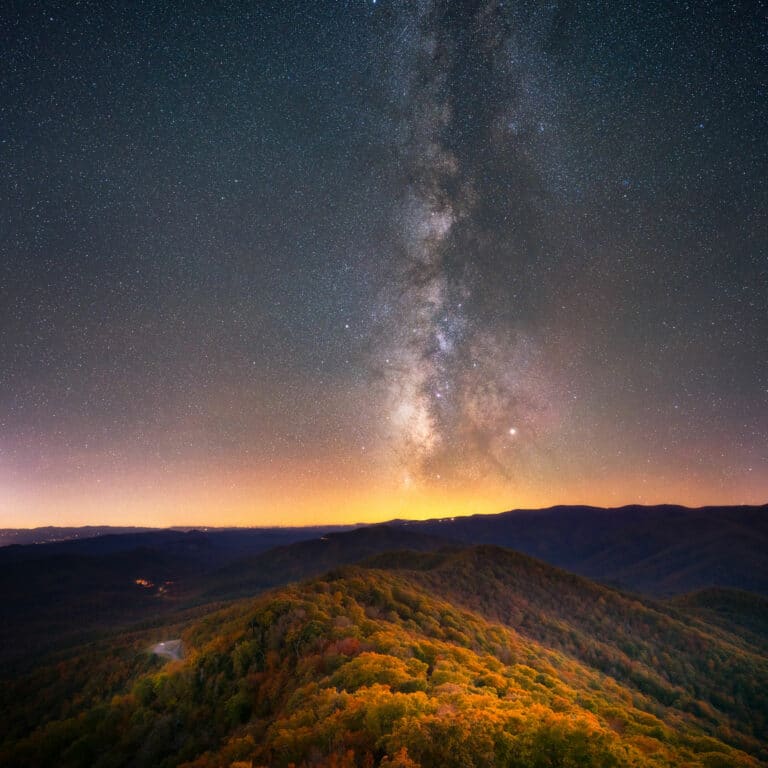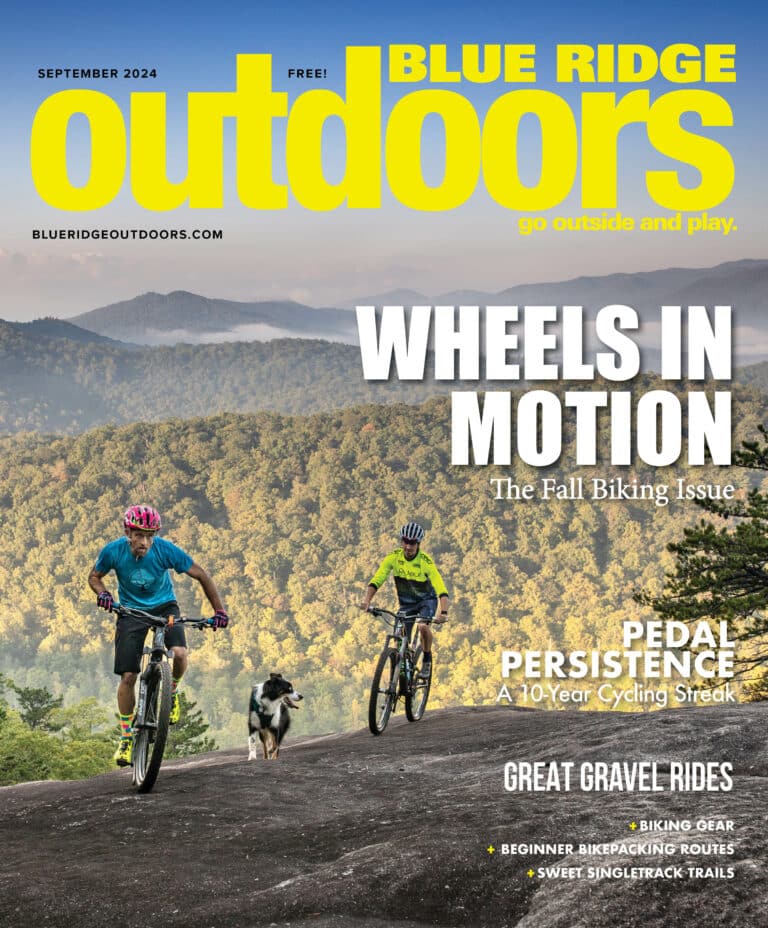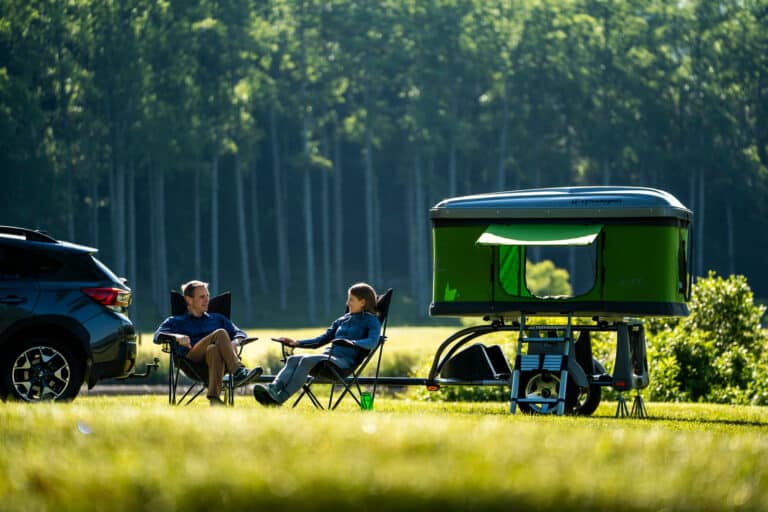Click here to watch exclusive climbing videos.
Explore the seven best river-carved canyons in the Southeast—including an oasis of first
ascents in the undiscovered Big South Fork.
Big South Fork
Big South Fork—the 80-mile gorge that straddles the Kentucky-Tennessee border—has more rock than a Metallica concert, but nobody’s climbing it. Maybe it’s the rattlesnakes, or the lack of trails, or the commitment it takes just to descend by foot into the rocky gorge. Whatever the reason, the miles of cliffs and boulders that define the Big South Fork are left virtually untouched by the chalky hands of climbers.
The Big South Fork River is the love child of the New and Clear Fork Rivers. The torrent of whitewater flows north from Tennessee into Kentucky on top of the Cumberland Plateau, leaving a 600-foot deep sandstone gorge in its wake, 80 miles of which is protected as the Big South Fork National Recreation Area. The federal designation encompasses 123,000 acres of the main gorge and its surrounding tributaries, most of which are encased by rock canyons. Caves, chimneys, rock bridges, rock shelters, cliffs that rise 250 feet from the valley floor, boulders the size of small houses—there is rock everywhere, and most of it is still waiting to be climbed for the first time.
“It’s an enigma in the climbing world,” Jeff Noffsinger says. “Big South Fork has around 4,000 miles of rock, and almost nobody climbs there.”
Noffsinger is a fixture on the Southeastern climbing scene, living in Nashville and putting up first ascents all over the region, particularly in Big South Fork. Since Noffsinger first climbed the Big South Fork in ’92, he’s notched an estimated 400 first ascents in the area, a feat that has made him personally responsible for the majority of the climbing development inside the gorge and its surrounding canyons. If you’re climbing a developed route in the Big South Fork, chances are good you’re climbing a Jeff Noffsinger route.
Even with Noffsinger’s tireless efforts, there is still plenty of route development to be done inside the park—a rarity in a region whose large crags were developed decades ago.
“I always considered the Big South Fork the great ‘land trust’ for Southeastern rock climbing,” says Jamie Dial, another veteran climber who’s worked with Noffsinger to develop some of the classic routes inside the gorge. “There’s the main gorge where much of the climbing exists, but a quick look at a topo reveals many other drainages that have cliffs everywhere.”
Most climbers usually compare the Big South Fork to Kentucky’s Red River Gorge when talking about the quantity and quality of rock available.
“The climbing in Big South Fork is as good or better than any other place I’ve been,” Noffsinger says. “Slab, face, overhangs, cracks, tons of untapped bouldering. The potential is huge.”
And that potential sits only a few hours from three major cities—Knoxville, Nashville, and Lexington. So where are all the climbers? If the Big South Fork’s rock rivals the Red River Gorge, then why isn’t it a major climbing destination like the Red?
Noffsinger believes it has something to do with the wildness and magnitude of the gorge. Big South Fork is managed as de facto Wilderness, so trails are scarce, signs are nonexistent, and bushwhacking is mandatory. The terrain is too rugged and primitive to attract the attention of your average rock climber.
Swiss Stockton owns Granite Arches guiding service. He’s climbed in the Big South Fork before, but usually chooses other locations, particularly when he’s guiding. “It’s not like you can just park and climb,” Stockton says. “The climbing there is great, but there is no infrastructure. It’s a place where you have to explore. It’s a place where you go to put up new routes.”
Most climbers would love to have a 123,000-acre crag all to themselves, and Noffsinger certainly enjoys the solitude that climbing at the Big South Fork affords, but surprisingly, he’s not averse to seeing more climbers on his cliffs.
“I wish more people climbed there. I realized a long time ago that there’s enough rock to go around up there. I’m never going to have to worry about crowds.”
Noffsinger even wrote a chapter about Big South Fork in the most recent edition of the Dixie Cragger’s Atlas, the bible of Southern rock. The beta attracted a few climbers, but not many. Jamie Dial doesn’t think the Big South Fork will become a major climbing destination any time soon. “It takes a different kind of person to go climbing there. The New and Red and T-Wall are ultra convenient. All a climber has to do is park, walk a few minutes down a decent trail, and climb. At the Big South Fork, a bunch of time goes to driving down dirt roads, finding a place to park, hiking in, and bushwhacking up a steep slope with no trails.”
Oddly enough, this is exactly what attracts Noffsinger to the Big South Fork. “I like the wilderness experience,” Noffsinger says. “I like getting out there, looking at a cliff that nobody’s climbed, then climbing it.”
———-
CLIMBING BIG SOUTH FORK
Even at the developed crags, Big South Fork is no place for beginners. Don’t expect groomed trails to the cliffs. Beware of rattlesnakes, which make their home in the boulders and rocks of Big South Fork. Also, the park is managed essentially as Wilderness, which means no motorized drills on the cliffs. If you want to put up bolts, you’ll have to hand drill them.
CLASSIC CLIMBS: The O&W Wall—a 250-foot cliff near the O&W Bridge has the highest concentration of multi-pitch trad routes. It is the biggest cliff that Noffsinger has found to date. It’s home to approximately 40 developed pitches, most of which are above 5.11. On the Kentucky side of Big South Fork, Blue Heron has over 50 developed routes below the Blue Heron Overlook. There’s a variety of sport and trad to choose from, most of which are in the 5.10-5.12 range. Blue Heron offers the gorge’s most accessible routes.
BEGINNER’S CLIMBS: Check out Block Party (5.7) and Charybdis (5.9) for easier mixed climbs up a 75-foot pillar.
CAMPING: Primitive camping is allowed throughout Big South Fork (except in the caves and under arches) but if you want showers and hookups, head to the Blue Heron Campground, which will put you close to the easier sport routes. Bandy Creek Campground is on the Tennessee side of the park, close to the O&W Wall.
———-
Little River Canyon
The Little River Canyon sits on the southern edge of Lookout Mountain in Alabama and is rumored to have some of the hardest climbing in the Southeast, with steep sandstone walls and routes that mostly fall between 5.11 and 5.14 in difficulty. Even more daunting than the terrain can be the local climbers who are rumored to guard the canyon from newcomers like a big brother protecting a little sister from suitors. The only guide to the Little River is a self-published, underground book that outsiders can’t get their hands on, but Chris Sierzant, a climber who’s been exploring Little River for years, says you shouldn’t believe everything you hear about the Little.
“The climbing isn’t as hard as people think. You can find everything from 5.8 in the canyon, and there are extensive 5.10s and 5.11s. If you’re a decent climber, it’s paradise.”
There are more than 400 established sport routes in the Little River, making it one of the best sport climbing destinations in the Southeast, and it’s rapidly becoming one of the top bouldering destinations as well.
“It’s a pioneer area,” Sierzant says. “The Little River is 26 miles of unexplored bouldering. Every branch of the river is littered with boulders. The canyon has limitless amounts of potential.”
CLASSIC CLIMB: The Lizard Wall is home to a number of classic overhanging sport routes, most of which are kept dry even during the rain thanks to a huge rock roof. For a true test of endurance, check out Another Doug Reed (5.12).
BEGINNER’S CLIMB: Skip the sport routes and try some shallow water bouldering. The Hippie Hole features a few overhanging boulders with soft landings in the shallow water.
CAMPING: There’s no camping inside the canyon, so most climbers head to nearby Desoto State Park.
———-
Potomac Gorge
On the edge of our nation’s capital, the Potomac River has forged a shallow, narrow chasm of rock 15 miles long, stretching from Great Falls to Georgetown. The cliffs average between 50 and 75 feet offering primo top-rope territory on either side of the river, with a high concentration of beginner climbs. On the Maryland side, most of the quality schist granite sits inside the Chesapeake and Ohio Canal National Park. On the Virginia side, the climbing is housed inside the Great Falls National Park.
There are more than 100 developed routes ranging from 5.5 to 5.8, and even more above 5.10. Friction slabs, overhangs, cracks—even the bouldering is good. And all of it is easily reached by a series of well-maintained hiking trails. To say it’s strange to have this much good rock climbing close to a major city is an understatement.
“The Potomac Gorge is a unique gem,” says Thomson Ling, coordinator with Access Fund. “Sure, it can get crowded on weekends, but the variety of rock and difficulty of the climbs all within the scenic gorge so close to D.C.—I love it.”
CLASSIC CLIMB: Aid Box is a crag on the Great Falls side of the gorge with some of the hardest climbs in the area. Check out Lost Arrow (5.10), a Great Falls classic granite crack climb with a tough overhang.
THE BEGINNER’S CLIMB: Carderock on the Maryland side of the river has a high concentration of beginner routes. Try Easy Layback for a 5.4 crack that serves as the perfect introduction to climbing the Potomac Gorge.
CAMPING: This is D.C. Get a hotel.
———-<br />
Red River Gorge
Exactly how much climbing is there in Kentucky’s Red River Gorge? Enough to make it a destination on every climber’s “Life List.” A whopping 29,000 acres of the Red is designated as a Geological Area, which is a fancy way of saying that this ditch has a lot of cool rock. There are an estimated 150 natural rock arches inside the gorge—the highest concentration of arches east of the Rockies—and the canyon walls are lined with extensive sandstone cliff bans. A couple thousand developed routes and countless boulders give the climbers something to choose from, which is good because the Red sees plenty of climbers.
“It’s a love-hate relationship,” says Amy Pickett, owner of Red River Outdoors. “People come from all over the world to climb here. We’d love to keep it all to ourselves, but the attention has its merits.”
Namely, respect. The Red River Gorge Climbers’ Coalition works tirelessly to make sure climber access stays on the forefront of the Daniel Boone National Forest’s management plan. They’ve even become landowners themselves. The coalition owns Pendergras-Murray Recreation Area, the country’s premiere privately owned climbing preserve.
CLASSIC CLIMB: Arachnid (5.8) is one of the routes that defines the gorge. It’s a crack climb with an intimidating roof transition into a dihedral to the finish.
BEGINNER’S CLIMB: Bedtime for Bonzo (5.6) in the northern section of the gorge is a multi-pitch crack climb. A few climbers with more talent than brains have been free-soloing it for years.
CAMPING: Miguel’s, a climber-owned pizza kitchen and campground, is the center of all things climbing at the Red.
———-
Linville Gorge
You want exposure? Linville’s got it. You want chimneys? Waterfall climbs? Deep water bouldering? Wilderness climbing? Multi-pitch? Whatever your chalky heart desires, Linville Gorge has it in spades. The gorge is 12 miles long, 2,000 feet deep, with rock on both sides, and it is classic Wilderness; expect to get lost on the maze of trails lacing the gorge floor.
In contrast to the rugged terrain, there are a surprising amount of beginner-friendly climbs throughout the gorge—just make sure you’re climbing with someone who knows what they’re doing. An accident inside Linville could prove to be fatal due to the difficulty of rescue.
CLASSIC CLIMB: Try the Bumblebee Buttress (5.8) for a three-pitch trad climb with great exposure. Some say the belay ledge at the top of the second pitch has the best view in the gorge.
BEGINNER’S CLIMB: The Mummy (5.5) is a three-pitch beginner climb with killer views inside the Amphitheater, a small canyon off the main gorge inside the Wilderness area. For beginner climbs that are easier to access, check out Table Rock’s East Face, which is full of multi-pitch routes in the 5.5 range.
CAMPING: Primitive camping abounds inside the gorge, but it’s a designated Wilderness so remember your Leave No Trace guidelines.
———-
New River Gorge
One of the oldest rivers in the world has given birth to one of the most popular climbing destinations in the world. More than 1,600 developed routes are scattered throughout the ten-mile, 70,000-acre New River Gorge in West Virginia. The sandstone cliff walls rise anywhere from 30 to 120 feet, making the New the premiere single pitch destination on the East Coast. The rock is super-featured and the variety of climbing is unparalleled. Crack addicts have plenty of fissures to choose from, sport routes are copious, and the bouldering is just now getting the attention it deserves.
Most of the routes tend to cater to the experienced climber, but there is plenty for beginners to choose from. More importantly, the approaches are relatively easy and most routes are concentrated in central crags. Walk a short trail to any sandstone wall inside the gorge, and you’ll have a weekend of routes within reach.
CLASSIC CLIMB: The Endless Wall offers quintessential New climbing, with heavily featured sport and trad routes and killer views of the gorge. Try Fantasy (5.8) for a sweet two-pitch crack climb, or head over to the Junkyard Wall for Four Sheets to the Wind (5.9), a wide crack climb into a dihedral that leads you into a series of roofs.
BEGINNER’S CLIMB: The Bridge Buttress is a good spot for novices. Check out Dairy Area (5.4) for an easy climb with good exposure, then work up Midnight Moonlight (5.7), a 65-foot dihedral with some tricky roofs.
CAMPING: Plenty of private campgrounds surround the New River. Check out Ace Adventure Center for cabins or camping.
———-
Tallulah Gorge
It took a hydroelectric dam to tame the river that Native Americans once dubbed “terrible.” The powerful Tallulah River cut a massive gorge through the granite of North Georgia, creating a canyon that is 1,000 feet deep and a mile long with steep rock walls on both sides. The dam not only tamed the tumultuous rapids, but it also made it possible for climbers to access the rock. Not that getting to the bottom of the gorge is easy. The access trail to the most popular climbing area includes a 40-foot class 4 scramble and a pass through a waterfall. And once you’re at the base of the Main Wall, the real work begins. Tallulah offers the hardest climbing in the Peach State, with long, forearm busting multi-pitch trad routes that tend to be 5.10 or harder.
Tallulah Gorge State Park is climber friendly, but because of the gorge’s rugged terrain and the difficult task that rescues pose, the management requires each climber to get a day permit and limits the number of climbers that access the gorge to 20 per day.
CLASSIC CLIMB: On Tallulah Gorge’s Main Wall, Punk Wave (5.10) is a three-pitch trad route with more exposure than a Jenna Jameson film.
BEGINNER’S CLIMB: Chimney Route (5.7) also on Tallulah’s Main Wall, is a two-pitch climb up two separate chimneys.
CAMPING: There’s a developed campsite (lots of RVs) inside the state park near the interpretive center. •







